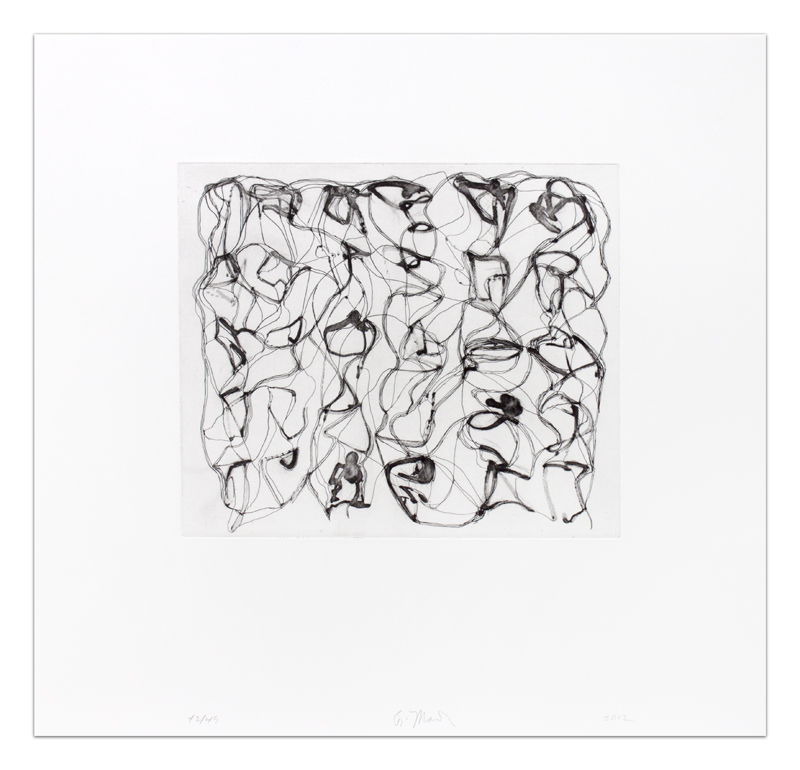
Image/plate size: 11 1/2 x 13 5/16 inches (29.2 x 33.8 cm)
Paper size: 21 5/8 x 22 3/8 inches (54.9 x 56.8 cm)
Frame size: 26 1/2 x 27 1/2 inches (67.3 x 69.9 cm)
Edition of 45
Signed ‘B. Marden’ lower center, numbered lower left and dated lower right in graphite
(Inventory #27915)
Image/plate size: 11 1/2 x 13 5/16 inches (29.2 x 33.8 cm)
Paper size: 21 5/8 x 22 3/8 inches (54.9 x 56.8 cm)
Frame size: 26 1/2 x 27 1/2 inches (67.3 x 69.9 cm)
Edition of 45
Signed ‘B. Marden’ lower center, numbered lower left and dated lower right in graphite
(Inventory #27915)
“It’s about touch and it’s about feeling and it’s very direct.”
Brice Marden
Since 1961 when a student at Boston University, Brice Marden has worked with etching. He has utilized line etching, sugarlift, aquatint and a myriad of other techniques. The two works by Marden included in “Woven” were made twenty years apart (1992 and 2012) and while there is a strong change within the overall structure of marks, a consistency reigns. The process of making a print – wiping, scraping, acid-etching, etc. as well as deciding how big and what paper to print upon – are all used by Marden to create a dynamic, sensitive, and quiet situation for contemplation. Simultaneous to this, he shows that the power of all the marks comes from their contingency to other marks. Compare, contrast, push, pull, and support are just some of the formal actions that Marden’s lines, planes and spaces do to and with each other.
Brice Marden was born in 1938 in Bronxville, New York and passed away in 2023. He attended Florida Southern College, Lakeland, from 1957 to 1958 and the Boston University School of Fine and Applied Arts from 1958 to 1961, where he received his BFA degree. In the summer of 1961, he attended Yale Norfolk Summer School of Music and Art in Norfolk, Connecticut, and went on to enroll at the Yale University School of Art and Architecture, New Haven, receiving an MFA degree in 1963.
It was at Yale that Marden developed the formal strategies that characterized his paintings of the following decades: a preoccupation with rectangular formats and the repeated use of a muted, extremely individualized palette. He has described his early works as highly emotional and subjective, despite their apparent lack of referentiality.
In the summer of 1963, Marden moved to New York with his wife, Pauline Baez, whom he had married in 1960, and with whom he had a son, Nicholas. They later divorced and he married Helen Harrington in 1969. He worked as a guard in 1963 and 1964 at the Jewish Museum, where he came into contact with the work of Jasper Johns, an artist whom he studied in depth and whose work furthered his interest in gridded compositions.
Marden made his first monochromatic single-panel painting in the winter of 1964. It was during this time that his first solo exhibition was presented at the Wilcox Gallery, Swarthmore College, Swarthmore, Pennsylvania. Marden spent the spring and summer of 1964 in Paris, where he was inspired by the work of Alberto Giacometti. His first solo show in New York was held at the Bykert Gallery in 1966, and in the fall of that year, he became the general assistant to Robert Rauschenberg. In 1968, he began constructing his paintings with multiple panels. From 1969 to 1974, he was a painting instructor at the School of Visual Arts in New York.
In 1972, his work was showcased at Documenta 5 in Kassel, and he was honored with a retrospective at the Solomon R. Guggenheim Museum, New York, in 1975. A show of drawings made between 1964 and 1974 traveled in 1974 to the Contemporary Arts Museum, Houston; the Fort Worth Art Museum; and the Minneapolis Institute of Arts. In 1977, Marden traveled to Rome and Pompeii, where he strengthened his interest in Roman and Greek art and architecture, which would influence his work of the late 1970s and early 1980s.
In the mid-1980s, Marden turned away from Minimalism toward gestural abstraction. Around this time, he traveled to Thailand, where he became interested in Far Eastern calligraphy and the art of the brush stroke. Marden’s recent large-scale paintings continue to employ “glyphs” inspired by Asian characters. During the 1990s, Marden continued to exhibit regularly in New York. He was the subject of two major traveling shows, Brice Marden-Cold Mountain, at the Dia Center for the Arts, New York (October 17, 1991-May 31, 1992); Walker Art Center, Minneapolis (June 28-September 13, 1992); Menil Collection, Houston (October 2-November 29, 1992); Museo Nacional Centro de Arte Reina Sofía, Madrid (January 12-March 15, 1993); Kunstmuseum, Bonn (April 30-June 20, 1993); and Work books 1964-1995, which traveled in 1997-98 to the Staatliche Graphische Sammlung, Munich; Kunstmuseum Winterthur, Switzerland; Wexner Center for the Arts, Columbus, Ohio; and the Fogg Art Museum, Harvard University, Cambridge, Massachusetts. In 2006, the Museum of Modern Art in New York organized a major retrospective of his paintings and drawings from October 29, 2006-January 15, 2007, which later traveled to the San Francisco Museum of Art (February 23-May 13, 2007) and the Hamburger Bahnhof in Berlin (June 12-October 7, 2007).
–Solomon R. Guggenheim Museum, New York, New York
10 Newbury Street, Boston, Massachusetts 02116
617-262-4490 | info@krakowwitkingallery.com
The gallery is free and open to the public Tuesday – Saturday, 10am – 5:30pm